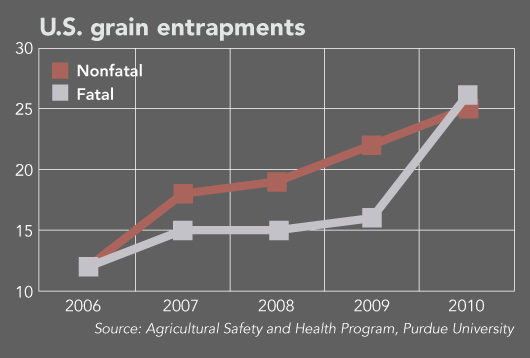More than a grain of danger
As grain-related injuries and deaths increase, OSHA cracks down

Deaths and injuries from grain entrapments are on the rise and, as a result, OSHA is warning grain facility owners and operators to take appropriate precautions – or face steep consequences.
In 2010, 51 grain entrapments were documented – the highest number ever reported, according to Purdue University’s Agricultural Safety and Health Program in West Lafayette, IN. The program has documented grain entrapment cases since 1978, with data going back to 1964. Seventy percent of all documented entrapments occur on farms exempt from OSHA’s grain handling facilities standard (1910.272).
In recent years, the number of deaths and injuries from these grain entrapments also has increased – 26 fatal and 25 nonfatal entrapments occurred last year. In 2006, there were only 12 each.
However, Purdue researchers stressed that these figures do not paint a complete picture. In a Feb. 9 summary on 2010 grain entrapments, the researchers noted that a nationwide comprehensive reporting system does not exist for grain entrapments, and some victims and employers may be reluctant to report such incidents when a public report was not made. Using figures from Indiana’s surveillance program, which researchers called “aggressive,” Purdue estimated the total number of nationwide grain entrapment cases could be as much as 30 percent higher.
Enforcement and outreach
OSHA has stepped up its enforcement of grain entrapment hazards. In the past year, the agency has issued more than $4 million in fines to only five companies for alleged safety violations stemming from incidents that killed five workers and injured two.
In an Aug. 4 letter sent to grain storage facility operators, OSHA administrator David Michaels highlighted the most recent tragedy (at the time). A 14- and 19-year-old were killed at an Illinois grain elevator while “walking down the corn,” a process that entails walking on top of grain to make it flow while machinery that evacuates the grain is running. The teen workers were engulfed and suffocated.
In the letter, Michaels provided a list of safety measures for operators to implement to limit injuries and deaths – including prohibiting walking down grain. Michaels also warned of OSHA penalties for violations and – in the event of an employee death – possible criminal prosecution by the Department of Justice.
In August, OSHA’s Region 5 launched a Local Emphasis Program on grain-related hazards.
According to the Purdue report, more than half of all documented grain entrapments occurred in that region, which includes Illinois, Indiana, Michigan, Minnesota, Ohio and Wisconsin. At press time, OSHA data showed the LEP had resulted in 61 inspections and 209 citations.
“Grain elevator owners and operators must implement well-known safety practices to prevent workers from being hurt or killed in a grain bin,” Michaels said in a March 16 press release announcing $465,500 in penalties against an Ohio-based grain operator related to the death of a 20-year-old worker.
Post a comment to this article
Safety+Health welcomes comments that promote respectful dialogue. Please stay on topic. Comments that contain personal attacks, profanity or abusive language – or those aggressively promoting products or services – will be removed. We reserve the right to determine which comments violate our comment policy. (Anonymous comments are welcome; merely skip the “name” field in the comment box. An email address is required but will not be included with your comment.)

